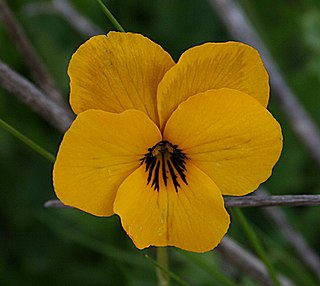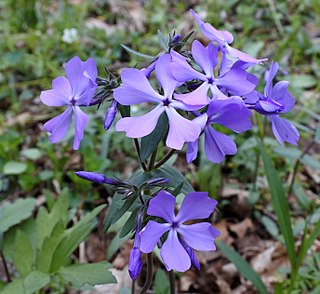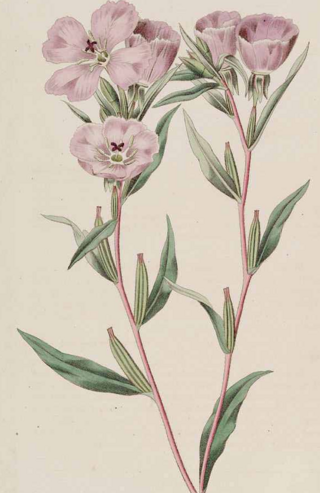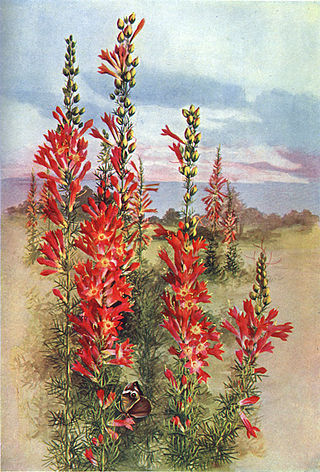
Viola pedunculata, the California golden violet, Johnny jump up, or yellow pansy, is a perennial yellow wildflower of the coast and coastal ranges in California and northwestern Baja California. The common name "Johnny jump up" is usually associated with Viola tricolor however, the introduced garden annual.

Aquilegia formosa, the crimson columbine, western columbine, or (ambiguously) "red columbine", is a common wildflower native to western North America, from Alaska to Baja California, and eastward to Montana and Wyoming.

A wildflower is a flower that grows in the wild, meaning it was not intentionally seeded or planted. The term implies that the plant is neither a hybrid nor a selected cultivar that is any different from the native plant, even if it is growing where it would not naturally be found. The term can refer to the whole plant, even when not in bloom, and not just the flower.

Eriophyllum lanatum, with the common names common woolly sunflower, Oregon sunshine and golden yarrow, is a common, widespread, North American plant in the family Asteraceae.

Philadelphus lewisii, the Lewis' mock-orange, mock-orange, Gordon's mockorange, wild mockorange,Indian arrowwood, or syringa, is a deciduous shrub native to western North America, and is the state flower of Idaho.

Dendromecon rigida, also called bush poppy or tree poppy, is a shrub or small tree of the Papaveraceae native to California and Baja California.

Fremontodendron californicum, with the common names California flannelbush, California fremontia, and flannel bush, is a flowering shrub native to diverse habitats in southwestern North America.

Ipomopsis aggregata is a species of biennial flowering plant in the phlox family, Polemoniaceae, commonly known as scarlet trumpet, scarlet gilia, or skyrocket because of its scarlet red flowers with lobes curving back as if blown back by rocketing through the air.

Phlox divaricata, the wild blue phlox, woodland phlox, or wild sweet william, is a species of flowering plant in the family Polemoniaceae, native to forests and fields in eastern North America.

Clarkia purpurea is a species of wildflower known by the common names winecup clarkia, winecup fairyfan, and purple clarkia.

Gilia brecciarum is an annual flowering plant in the phlox family (Polemoniaceae), known by the common name Nevada gilia or break gilia.

Gilia cana is a species of flowering plant in the phlox family known by the common name showy gilia. It is native to California and Nevada where it grows in open areas with gravelly and sandy soils, such as desert and rocky slopes. The Mojave Desert range of some subspecies may extend into Arizona.

Gilia capitata is a species of flowering plant in the phlox family known by the common names blue-thimble-flower, bluehead gilia, blue field gilia, and globe gilia.
Gilia ophthalmoides is a species of flowering plant in the phlox family known by the common name eyed gilia. It is native to the Southwestern United States where it can be found in woodlands and high desert plateau.

Caltha leptosepala, the white marsh marigold, twinflowered marsh marigold, or broadleaved marsh marigold, is a North American species of flowering plant in the buttercup family. The species has regionally distinct variations.

Encelia actoni, also known by the common names Acton brittlebush and Acton encelia, is a species of flowering plant in the family Asteraceae.

Gilia salticola is a species of flowering plant in the phlox family known by the common name salt gilia. It is native to the Sierra Nevada and Modoc Plateau of California and western Nevada, where it grows in volcanic and granitic soils.

Rosa woodsii is a species of wild rose known by the common names Woods' rose, interior rose, common wild rose, mountain rose, pear-hip rose, and prairie rose.

Sidalcea oregana is a species of flowering plant in the mallow family known by the common name Oregon checkerbloom.

Ipomopsis rubra is a flowering plant of the phlox family native to North America in the state of Texas and the southeastern United States, commonly known as standing cypress, scarlet gilia, Texas plume, flame flower, and indian spur. This classification is synonymous with Gilia rubra. This flower is noteworthy for its bright, upturned flowers.























